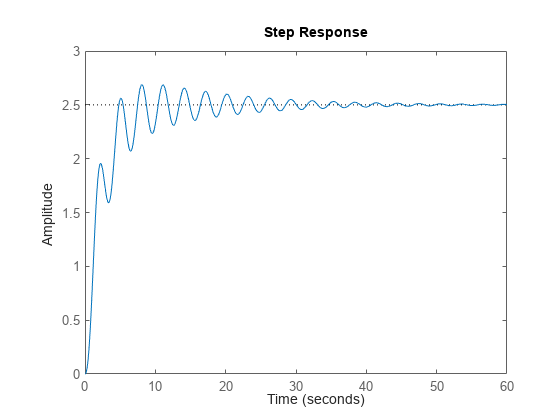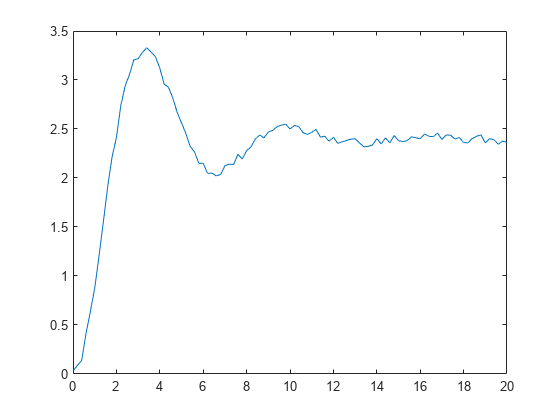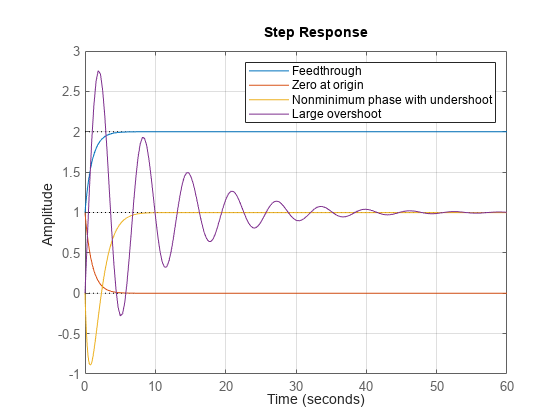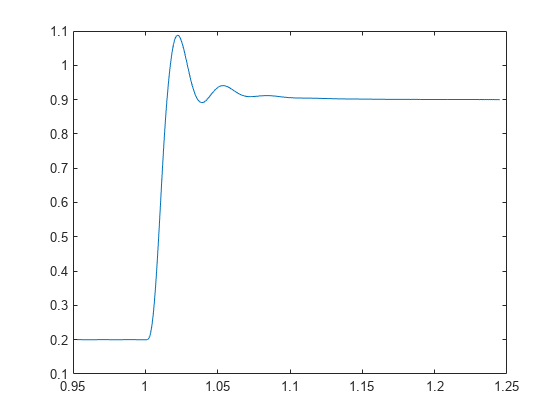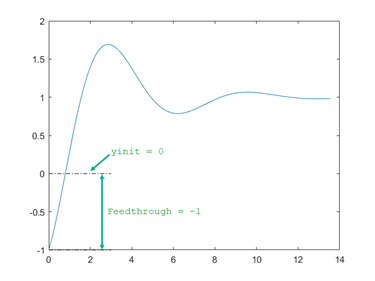stepinfo
Rise time, settling time, and other step-response characteristics
语法
说明
stepinfo lets you compute step-response characteristics for a dynamic system model or for an array of step-response data. For a step response y(t), stepinfo computes characteristics relative to yinit and yfinal, where yinit is the initial offset, that is, the value before the step is applied, and yfinal is the steady-state value of the response. These values depend on the syntax you use.
For a dynamic system model
sys,stepinfouses yinit = 0 and yfinal = steady-state value.For an array of step-response data
[y,t],stepinfouses yinit = 0 and yfinal = last sample value ofy, unless you explicitly specify these values.
For more information on how stepinfo computes the step-response characteristics, see Algorithms.
The following figure illustrates some of the characteristics stepinfo computes for a step response. For this response, assume that y(t) = 0 for t < 0, so yinit = 0.
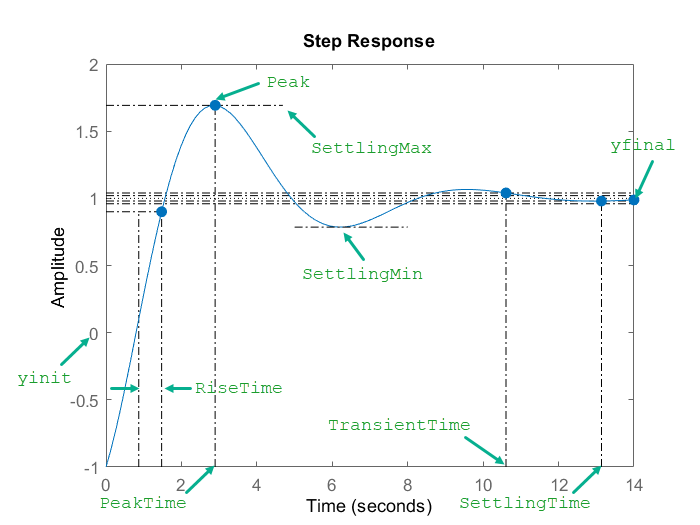
S = stepinfo(y,t)y and a corresponding time vector t. For SISO system responses, y is a vector with the same number of entries as t. For MIMO response data, y is an array containing the responses of each I/O channel. This syntax uses yinit = 0 and the last value in y (or the last value in each channel's corresponding response data) as yfinal.
S = stepinfo(y,t,yfinal)yfinal. This syntax is useful when you know that the expected steady-state system response differs from the last value in y for reasons such as measurement noise. This syntax uses yinit = 0.
For SISO responses, t and y are vectors with the same length NS. For systems with NU inputs and NY outputs, you can specify y as an NS-by-NY-by-NU array (see step) and yfinal as an NY-by-NU array. stepinfo then returns a NY-by-NU structure array S of response characteristics corresponding to each I/O pair.
S = stepinfo(y,t,yfinal,yinit)yinit. This syntax is useful when your y data has an initial offset; that is, y is nonzero before the step occurs.
For SISO responses, t and y are vectors with the same length NS. For systems with NU inputs and NY outputs, you can specify y as an NS-by-NY-by-NU array and yinit as an NY-by-NU array. stepinfo then returns a NY-by-NU structure array S of response characteristics corresponding to each I/O pair.
S = stepinfo(___,'RiseTimeLimits',RT)RT = [0.1 0.9]). The upper threshold RT(2) is also used to calculate SettlingMin and SettlingMax. These values are the minimum and maximum values of the response occurring after the response reaches the upper threshold. You can use this syntax with any of the previous input-argument combinations.
示例
输入参数
Output Arguments
算法
For a step response y(t), stepinfo computes characteristics relative to yinit and yfinal. By default, for a dynamic system model sys, stepinfo uses yinit = 0 and yfinal = steady-state value.
This table shows how stepinfo computes each characteristic.
| Step-Response Characteristic | Description |
|---|---|
RiseTime | Time it takes for the response to rise from 10% to 90% of the way from yinit to yfinal |
TransientTime | The first time T such that the error |y(t) – yfinal| ≤ SettlingTimeThreshold × emax for t ≥ T, where emax is the maximum error |y(t) – yfinal| for t ≥ 0. By default, SettlingTimeThreshold = 0.02 (2% of the peak error). Transient time measures how quickly the transient dynamics die off. |
SettlingTime | The first time T such that the error |y(t) – yfinal| ≤ SettlingTimeThreshold × |yfinal – yinit| for t ≥ T. By default, |
SettlingMin | Minimum value of y(t) once the response has risen |
SettlingMax | Maximum value of y(t) once the response has risen |
Overshoot | Percentage overshoot. Relative to the normalized response ynorm(t) = (y(t) – yinit)/(yfinal – yinit), the overshoot is the larger of zero and 100 × max(ynorm(t) – 1). |
Undershoot | Percentage undershoot. Relative to the normalized response ynorm(t), the undershoot is the smaller of zero and –100 × min(ynorm(t) ). |
Peak | Peak value of |y(t) – yinit| |
PeakTime | Time at which the peak value occurs |
For complex responses, stepinfo computes RiseTime, Overshoot, and Undershoot from the projection of y(t) onto the ray joining yinit to yfinal. All other characteristics of complex responses have the same definition as in the preceding table and are computed based on the magnitudes of the complex values in y, yinit, and yfinal. The following figure shows the 10% and 90% rise-time points projected onto the ray from yinit to yfinal. (自 R2025a 起)

